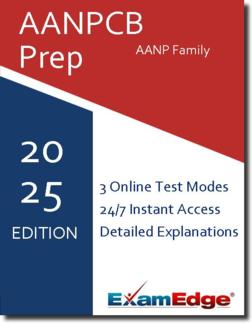AANP FNP Practice Tests & Test Prep by Exam Edge - Topics
Based on 40 Reviews
- Real Exam Simulation: Timed questions and matching content build comfort for your AANP Family NP test day.
- Instant, 24/7 Access: Web-based AANP Family Nurse Practitioner practice exams with no software needed.
- Clear Explanations: Step-by-step answers and explanations for your AANPCB exam to strengthen understanding.
- Boosted Confidence: Reduces anxiety and improves test-taking skills to ace your AANP Family Nurse Practitioner (AANP-FNP).

Understanding the exact breakdown of the AANP Family Nurse Practitioner test will help you know what to expect and how to most effectively prepare. The AANP Family Nurse Practitioner has 135 multiple-choice questions The exam will be broken down into the sections below:
| AANP Family Nurse Practitioner Exam Blueprint | ||
|---|---|---|
| Domain Name | % | Number of Questions |
| Assessment | 32% | 22 |
| Diagnosis | 27% | 18 |
| Plan | 26% | 18 |
| Evaluation | 15% | 10 |
| * Patient Ages | ||
| Prenatal | 2% | 1 |
| Newborn | 2% | 1 |
| Infant | 3% | 2 |
| Child | 6% | 4 |
| Early Adolescent | 5% | 3 |
| Late Adolescent | 9% | 6 |
| Young Adult | 19% | 13 |
| Middle Adult | 24% | 16 |
| Older Adult | 22% | 15 |
| Elder Adult | 8% | 5 |
The AANP Family Nurse Practitioner (FNP) exam assesses candidates across four primary testing domains, which are essential for entry-level nurse practitioner practice. As of 2024, the test blueprint underwent changes to emphasize assessment, diagnosis, and planning, along with a redistribution of patient populations by age. Here's a summary of the domains and changes:
AANP Family Nurse Practitioner (FNP)Testing Domains:
- Assess (32% of questions): This domain focuses on the candidate's ability to obtain subjective information from patients, perform physical examinations, and order, perform, and interpret screening and diagnostic tests.
- Diagnose (26.5% of questions): It examines the candidate's capability to synthesize and analyze subjective and objective information to develop a differential diagnosis list, prioritize the differentials, and establish a diagnosis.
- Plan (26.5% of questions): This domain tests the ability to establish a patient-centered, evidence-based plan of care; initiate referrals or consultations; prescribe, order, or administer treatments; and deliver education, counseling, and health promotion. Evaluate (15% of questions): It assesses the candidate's proficiency in evaluating the effectiveness of the plan of care and modifying it based on patient outcomes.
AANP Family Nurse Practitioner (FNP) Changes in 2024:
- Assessment Emphasis: There's an increased focus on the Assess domain, reflecting a higher percentage of questions in this area.
- Age Distribution Adjustments: Notable changes include the removal of prenatal as a separate age category, introduction of a toddler category, and removal of the elder adult category. Questions related to prenatal health are now embedded in the adolescent, young adult, and middle adult categories.
AANP Family Nurse Practitioner (FNP) Exam Details:
- The FNP exam contains 150 questions, with 135 being scored and 15 unscored pretest questions.
- Candidates have 3.5 hours to complete the exam.
- The exam fee is $240 for AANP members and $315 for nonmembers, with paper applications incurring additional costs.
- AANPCB exams are administered at Prometric testing centers.


